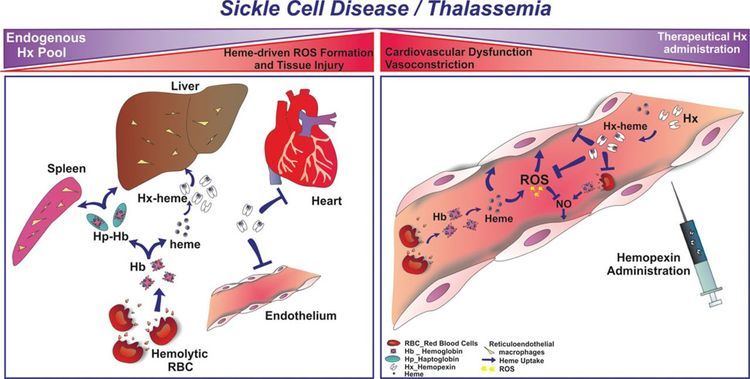Aliases HPX, HX, hemopexin Ensembl ENSG00000110169 | Entrez 3263 | |
 | ||
External IDs OMIM: 142290 MGI: 105112 HomoloGene: 511 GeneCards: HPX | ||
Gene music using protein sequence of hpx hemopexin
Hemopexin (or haemopexin; HPX), also known as beta-1B-glycoprotein is a protein that in humans is encoded by the HPX gene and belongs to hemopexin family of proteins. Hemoglobin and its scavenger protein hemopexin (Hx) associate with HDL and influence the inflammatory properties of HDL. In addition it can also be said that HDL from Hx-null mice is proinflammatory. Moreover, Hemopexin deficiency is associated with various other inflammatory diseases such as septic shock and experimental autoimmune encephalomyelitis.
Contents
- Gene music using protein sequence of hpx hemopexin
- What does hemopexin mean
- Cloning expression and discovery
- Mapping of hemopexin gene
- Function
- Clinical significance
- Controversies
- Mutations
- Differential transcriptional pattern of hemopexin gene
- References
What does hemopexin mean
Cloning, expression and discovery
Takahashi et al. (1985) determined that human plasma beta-glycoprotein hemopexin consists of a single polypeptide chain of 439 amino acids residues with six intrachain disulphide bridges and has a molecular mass of approximately 63 kD. The amino-terminal threonine residue is blocked by an O-linked galactosamine oligosaccharide, and the protein has five glucosamine oligosaccharides N-linked to the acceptor sequence Asn-X-Ser/Thr. The 18 tryptophan residues are arranged in four clusters, and 12 of the tryptophans are conserved in homologous positions. Computer-assisted analysis of the internal homology in amino acid sequence suggested duplication of an ancestral gene thus indicating that hemopexin consists of two similar halves. Altruda et al. (1988) demonstrated that the hemopexin gene spans approximately 12 kb and is interrupted by 9 exons. The demonstration shows direct correspondence between exons and the 10 repeating units in the protein. As the introns were not placed randomly; they fell in the center of the region of amino acid sequence homology in strikingly similar locations in 6 of the 10 units and in a symmetric position in each half of the coding sequence. From these observations, Altruda et al. (1988) concluded that the gene evolved through intron-mediated duplications of a primordial sequence to a 5-exon cluster.
Mapping of hemopexin gene
Cai and Law (1986) prepared a cDNA clone for hemopexin, by Southern blot analysis of human/hamster hybrids containing different combinations of human chromosomes, assigned the hemopexin gene to human chromosome 11. Law et al. (1988) assigned the hemopexin gene to 11p15.5-p15.4, the same location as that of the beta-globin gene complex by in situ hybridization.
Function
Hemopexin binds heme with the highest affinity of any known protein. Its function is scavenging the heme released or lost by the turnover of heme proteins such as hemoglobin and thus protects the body from the oxidative damage that free heme can cause. In addition, hemopexin releases its bound ligand for internalisation upon interacting with a specific receptor situated on the surface of liver cells. This function of hemopexin is to preserve the body's iron. Hemopexin, an acute phase protein, can downregulate the angiotensin (ang) II type 1 receptor (AT1-R) in vitro.
Hx-dependent uptake of extracellular heme can lead to the deactivation of Bach1 repression which leads to the transcriptional activation of antioxidant heme oxygenase-1 gene. There are certain levels of circulating Hx which implicates in the prognosis for patients with septic shock. Therefore, it can also be said that, Hx therapy has been shown to be beneficial in cardiovascular disease, cerebral ischemic injury, and experimental autoimmune encephalomyelitis.
Clinical significance
Its levels in serum reflect how much heme is present in the blood. Therefore, low hemopexin levels indicates that there has been significant degradation of heme containing compounds and hemopexin is made to scavenge any heme it can. Low hemopexin levels are one of the diagnostic features of an intravascular hemolytic anemia.
Controversies
In past there have been reports showing from patients with sickle cell disease, spherocytosis, autoimmune hemolytic anemia, erythropoietic protoporphyria and pyruvate kinase deficiency which have been suggested that Haptoglobin (Hp) depletion in plasma occurs prior to the decline of hemopexin (Hx) concentrations (Muller-Eberhard et al., 1968). Heme released during oxidation of Hb to met-Hb or from heme saturated hepatocytes is bound by albumin and rapidly transferred to Hx, the plasma protein with the highest binding affinity for heme. Hx is glycoprotein produced by the liver with a plasma concentration of 1–2 mg/ml (Muller-Eberhard et al., 1968). Hx prevents heme's pro-oxidant and pro-inflammatory effects and it also promotes its detoxification, specifically when Hp concentrations are low or depleted in cases of severe or prolonged hemolysis. Hp and Hx, both are acute-phase proteins,induced during infection and inflammatory states to minimize tissue injury and facilitate tissue repair.The current review also suggests that the primary mechanisms by which Hp and Hx prevent heme toxicity prior to monocyte or macrophage clearance, it also critically evaluate the difference in genetic phenotype function and describe the rationale for exogenous Hp and Hx as therapeutic proteins.
Mutations
Deletion of the hemopexin or heme oxygenase-2 gene can aggravates brain injury followed by stroma-free hemoglobin-induced intracerebral haemorrhage.
Differential transcriptional pattern of hemopexin gene
The expression of the human hemopexin gene in different human tissues and cell lines was carried out by using the specific cDNA probe. From the results obtained it can be concluded that this gene is expressed in liver and, in lower amount, in hepatoma cell lines but not in kidney, spleen, placental cells, and in HeLa, fibroblast cell lines.By S1 mapping it can also said that the transcription initiation site in hepatic cells is 28 base pairs upstream from the AUG initiation codon of the hemopexin gene.
